June 19, 2025 | 12:01 GMT +7
June 19, 2025 | 12:01 GMT +7
Hotline: 0913.378.918
June 19, 2025 | 12:01 GMT +7
Hotline: 0913.378.918
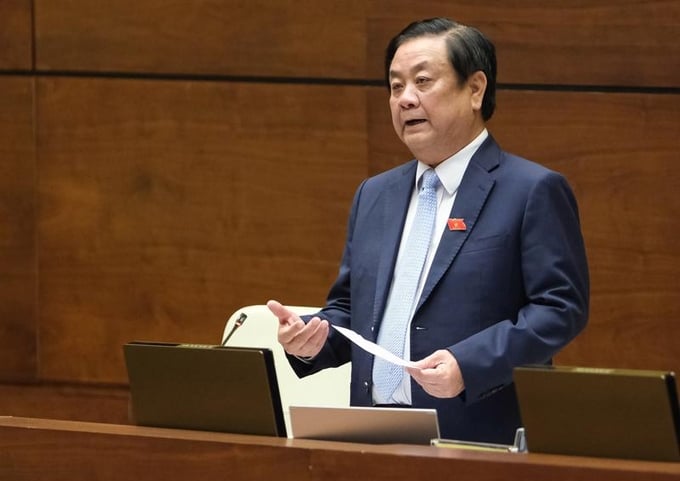
Minister Le Minh Hoan will answer three topics before the National Assembly Standing Committee on August 15 afternoon.
Conclusion No. 81-KL/TW of the Politburo (dated July 29, 2020) and Resolution No. 34/NQ-CP of the Government (dated March 25, 2021) highlight the need to improve the efficiency of agricultural land. By 2030, the Government aims to maintain 3.5 million hectares of rice land, sustain an annual rice output of at least 35 million tons, and export about 4 million tons of rice.
In the 2021-2025 period, the National Assembly promulgates Resolution No. 39/2021/QH15 on national land use planning for 2021-2030, with a vision for 2050. The resolution sets a target to reduce the area for rice cultivation to about 3.5 million ha by 2030. In addition, the solution allows flexibly changing the structure of crops and livestock within 300,000 ha of rice land, but without changing the nature and conditions of land use for rice cultivation. This enables farmers to switch back to rice farming when necessary, restrict and control the conversion of rice land to non-agricultural land, especially industrial zone land.
In a report sent to the National Assembly, MARD Minister Le Minh Hoan said that the Ministry of Natural Resources and Environment (MONRE) is responsible before the Government for unified land management. According to Decision No. 387/QD-BTNMT (dated March 2, 2022) of MONRE, the country’s rice land area is nearly 4 million hectares.
Regarding production, with the average output of the past years, Vietnam consistently reaches and exceeds the threshold of 43 million tons of rice per year. Data shows the domestic demand for rice is about 24 million tons, including national reserve, breeding, processing and production of animal food sources. To guarantee a high safety level, MARD confirms that the amount of rice to ensure food security for 100 million people and other domestic consumption needs is about 29.5 million rice tons per year. Thus, there is about 13.5 million tons of surplus rice, allowing the export of 7-8 million tons.
Besides rice, Vietnam annually produces an average of more than 7 million tons of meat, 10 million tons of aquatic products, and tens of millions of tons of vegetables and fruits. Thus, overall, food security is always guaranteed at the national level.
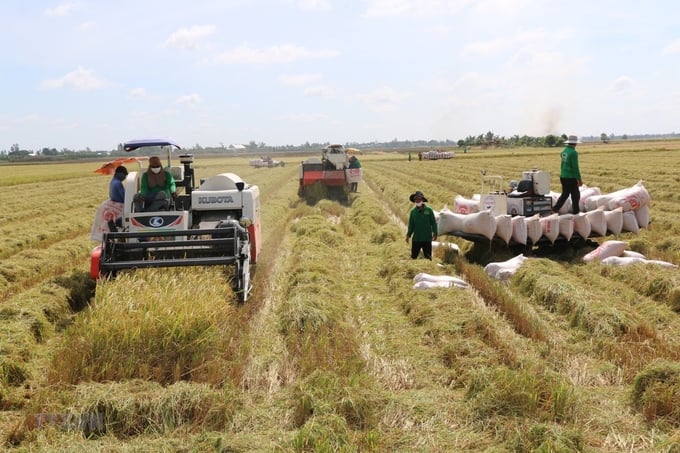
Harvesting rice in the Dong Thap Muoi area.
In the first seven months of 2023, the total export turnover of agricultural, forestry, and fishery products reached 29.13 billion USD, down about 9% over the same period in 2022. However, enterprises have also taken the opportunity to promote the export of advantageous commodity groups.
Four items with an outstanding export value over the same period are vegetables and fruits (US$3.2 billion, up 68%), rice ($2.58 billion, up nearly 30%), coffee ($2.76 billion, up 6%), cashews ($1.95 billion, up almost 10%).
Currently, the output market is narrowed, market demand is slow to recover, businesses have no orders, some key agricultural products have reduced in price, and farmers’ incomes and livelihoods are affected. Therefore, MARD acknowledges the precarious situation in which opportunities and challenges are intertwined. Vietnamese agricultural products can still be exported while India and some countries stop exporting rice; Thailand recommends reducing rice cultivation to avoid the El Nino phenomenon; climate change risks faster than expected impact on agriculture.
In the last months of 2023, MARD will implement three critical solutions. First, the officials will update, analyze and evaluate market information and developments comprehensively and carefully. This process will promptly disseminate and support people and businesses to overcome difficulties and take advantage of market opportunities. Secondly, MARD will coordinate flexible production, ensure food security and safety for domestic consumption, and supply for export demand. Thirdly, MARD will coordinate with the Ministry of Foreign Affairs and the Ministry of Industry and Trade to effectively promote the outstanding quality of Vietnamese agricultural products in domestic and foreign markets.
In the long term, the agricultural industry will continue to refine policies and laws, developing trademarks and brands of key farm products. At the same time, MARD will organize sustainable agricultural production according to the goals and orientations in the Sustainable Agriculture and Rural Development Strategy and specific solutions in the ongoing projects. These projects include: piloting the construction of primeval areas of agricultural and forest products to meet standards for domestic consumption and export between 2022 and 2025; ensuring food safety, and improving the quality of agricultural, forestry, and fishery products associated with the consumption market.
In addition, MARD is committed to speeding up the development, submitting to the Government for promulgation and implementation of the “1 million hectares of low-emission and high-quality rice” in the Mekong Delta and “System development to improve the quality and competitiveness of Vietnamese agricultural products by 2030, with a vision to 2050.”
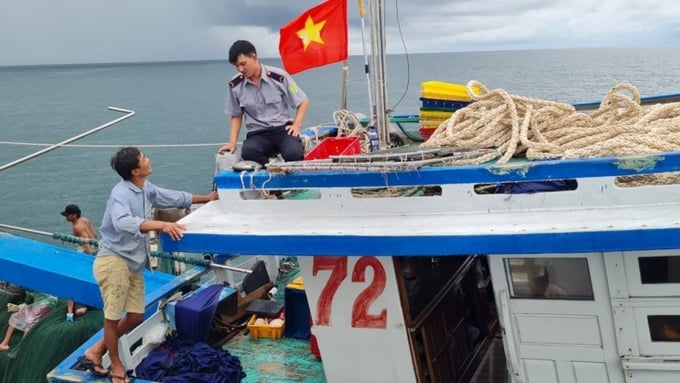
Fisheries control forces in Kien Giang province promote and disseminate regulations to fishermen.
Rigorously solve IUU fishing
In 2022, the seafood industry will grow in output and export value. Specifically, production value increased by over 4% compared to 2021; the total output reached more than 9 million tons, up 2.7%; exports reached about 11 billion USD, up nearly 24%.
In order to develop fishery resources sustainably, the agricultural sector advocates increasing aquaculture and reducing the intensity of exploitation. With the average reserve of marine resources in Vietnam’s waters estimated at 3.95 million tons, MARD continues to reduce fishing output, which reached 3.6 million tons by 2022. Alongside, 11 over 16 marine protected areas were established, with an area of about 175,000 hectares. These areas release more than 400 million breedings between 2012 and 2020. This approach focuses on species of economic value, native species, and endangered, precious, and rare aquatic species.
In the future, MARD will rigorously coordinate and effectively implement the Master Plan on Protection and Production of Aquatic Resources in 2021 - 2030 and the National Program on Protection and Development of Aquatic Resources 2023 - 2030. MARD will also review, adjust and establish new marine protected areas at national and provincial levels to conserve at least 6% of the marine area.
Protection of fishery resources needs to go hand in hand with monitoring fishing activities, which are managed through quotas on fishing licenses. Based on the investigation and assessment of fishery resource reserves, the maximum total fishery output, and the production sea areas, MARD will determine and assign quotas for fishing permits by species in offshore locations for provinces and cities.
On that basis, the People’s Committee of provinces will determine the quota for the fishing license and the allowable catch by species in coastal and inland areas under its management. License quotas are announced and adjusted every 60 months.
Through investigation, there are currently 80 fishing ports eligible to operate; 53 fishing ports are suitable for certifying the origin of aquatic products from fishing; 62 fishing ports for offshore fishing vessels to dock. Port management has been put in order, announced and well managed under the fishing license quota; the number of fishing vessels decreases year by year.
The total number of individual ships by the end of June 2023 is maintained at about 86,000 ships, of which mainly ships from 6-12m. The whole country has 5,810 production teams at sea, with 48,000 ships participating in production and 252,000 fishermen and trying to maintain it until the end of 2023.
Until now, nearly 85% of existing fishing vessels have been registered and updated on the national database of the fisheries sector for monitoring and management. About 15% of the remaining ships are not eligible for registration and are monitored by local agencies. Nearly 29,000 fishing vessels have installed cruise monitoring equipment (about 98%). However, the number of fishing vessels violating regulations on maintaining the connection to the monitoring system of fishing vessels is still typical.
This is also one reason why Vietnam has been unable to remove the IUU yellow card. Three main issues identified by MARD are: Vietnamese fishing vessels still violate foreign waters for illegal fishing; certifying and tracing the origin of aquatic products from domestic fishing, mainly imported ones, still has many shortcomings and limitations, which have not met the EC’s traceability requirements; and the handling of IUU fishing acts is still limited.
MARD aims to mobilize the whole political system to get involved, removing the IUU yellow card as soon as possible. In doing so, MARD focuses on five main groups of solutions. In particular, MARD will coordinate with the Ministry of National Defense, the Ministry of Public Security, and the People’s Committees of provinces and cities to prevent the situation of illegal fishing vessels in foreign waters.
MARD Minister Le Minh Hoan will answer questions before the National Assembly Standing Committee on August 15 afternoon. This is one of the activities held at the 25th session. The question-and-answer session for the group of issues in the agricultural sector on August 15 afternoon will be coordinated by Vice Chairman of the National Assembly Nguyen Duc Hai.
Deputy Prime Minister Tran Luu Quang and the Ministers of Finance, Industry and Trade, Natural Resources and Environment, Science and Technology, Information and Communication, and Foreign Affairs are sharing the hotspot with the leader of the agricultural sector. National Assembly Chairman Vuong Dinh Hue will deliver the opening and closing remarks for the entire questioning session.
Translated by Quynh Chi
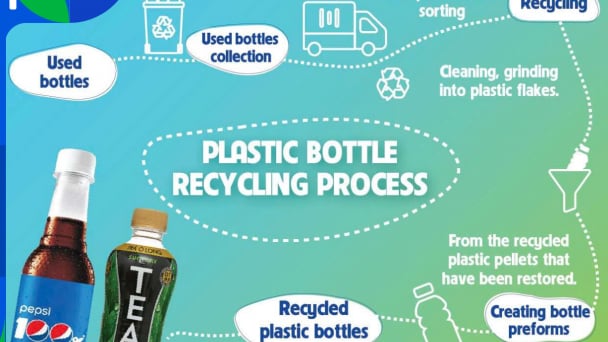
(VAN) To address plastic pollution, closing the plastic recycling cycle will bring significant economic and environmental benefits.
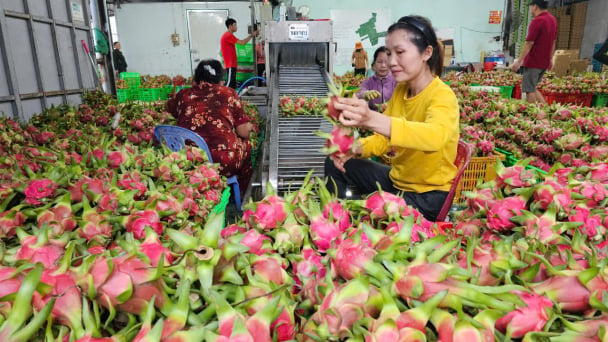
(VAN) According to the Binh Thuan Department of Industry and Trade, in the first five months of 2025, Binh Thuan's dragon fruit export turnover increased by 20.65% compared to the same period last year.
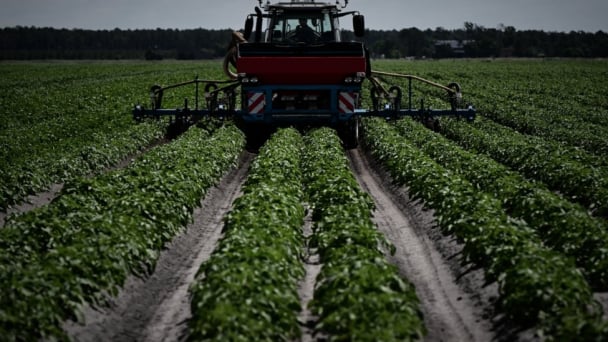
(VAN) EU countries on Thursday gave final approval to new tariffs on fertilizer imports from Russia, a move aimed at cutting off revenue that could support Moscow’s war in Ukraine, despite concerns from European farmers.
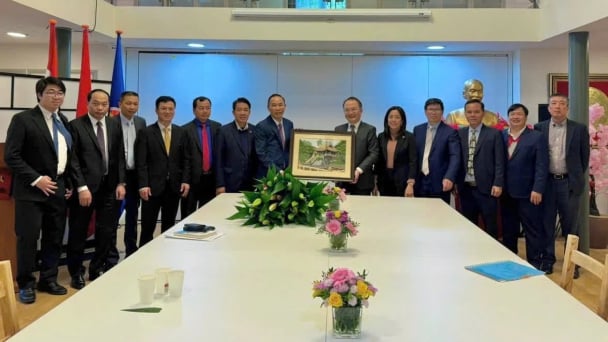
(VAN) The working delegation from the Ministry of Agriculture and Environment conducted an important trip to the Netherlands to strengthen strategic partnerships and sustainable development in the agricultural sector.
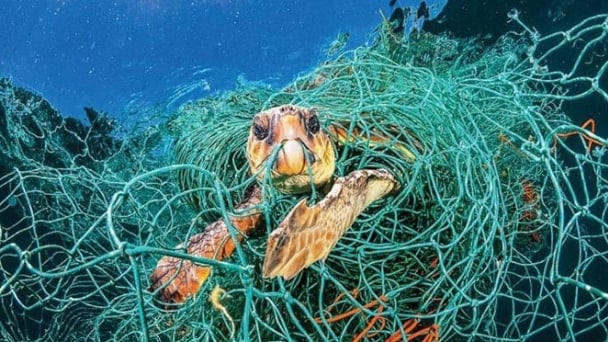
(VAN) The letter ‘A Plea from the Ocean’ not only evokes emotion but also awakens the human conscience to the responsibility of protecting life on Earth.

(VAN) The Department of Agriculture in South Africa has announced the country’s first mass vaccination of poultry to prevent local birds from contracting avian influenza.

(VAN) Establishment of the Mekong Delta Regional Agricultural Linkage Center, aiming for a closed value chain, deep processing, trading platforms, and international market connectivity.